Award winner Lonika Chande's warm, inviting west London cottage
We didn't want to make it something it isn't,' says the interior designer Lonika Chande of the Queen's Park cottage that she shares with her husband, Theo, and one-year-old son, Sasha. Built in 1876, the house forms part of a network of pretty brick terraced cottages, sandwiched between Kilburn Lane and Harrow Road, which were designed to offer affordable yet characterful housing – complete with ornamental stonework, gabled porches and even the odd turret – for the Victorian working classes.
There have inevitably been changes over the past 100 years: some streets were Blitz casualties, while other cottages were altered before it was designated a conservation area in 1978. When Lonika and Theo bought this one in 2016, it had been ‘done’ – the walls freshly painted, new oak floorboards installed downstairs and the back of the house extended to accommodate a larger kitchen. Although the layout worked well – with the sitting room at the front, the kitchen opening onto the back garden, two bedrooms and a bathroom upstairs, and a smaller study space in the attic – it felt removed from its humble origins as a railway worker’s cottage.
‘We wanted to recapture some of its original character, so we stripped out everything other than the floors and started again,’ says Lonika. Floor-to-ceiling tongue and groove was added in the bathroom – a space she has reconfigured to squeeze in a bath and shower – while panelling was added in the sitting room. Here, she opened up a boarded fireplace, pairing an Ebay grate with a wooden surround of her own design. Else-where, she perfected what was already there: in the main bedroom adding green-gloss panelled doors with a decorative pelmet to the wardrobes.
Lonika was well placed to take on the challenge, having just set up her own studio, which offers half-day consultations as well as full-scale interior design. Prior to this, she had honed her skills with a year’s decorating course at Inchbald School of Design, and stints at architectural practice PDP, Northacre and interior designer Juliette Byrne.
With the structure and layout in place, Lonika set about combining antique pieces, fabrics and strong colours. The palette is warm and cheerful, offset by neutral tones on the floors and walls. In Sasha’s nursery – the only room with wallpaper – a bold CFA Voysey design from Trustworth Studios lines the walls, which Lonika combined with glossy red woodwork and papier-mâché letters from Edit58: ‘I didn’t want it to feel twee.’
Very often, textiles – in which Lonika invested a good chunk of her budget – were the starting point for each room. In the bathroom, it was Robert Kime’s ‘Field Poppy’, which she used for the relaxed roman blind, while in the cosy sitting room she opted for ‘Dans la Forêt’ from Décors Barbares to upholster a bespoke skirted sofa from David Seyfried. A green striped deckchair canvas set the tone for her and Theo’s bedroom. ‘It was left over from the backdrop at our wedding, so it was lovely to use it for the headboard,’ she says. A bed canopy brought more fabric into the space, including a block print from Jaipur and a sunny yellow washed linen from The Cloth Shop.
No doubt Lonika’s enthusiasm for colour comes, in part, from having grown up in a creative family – her grandmother is a former antique dealer and her mother is the artist Lucy Dickens, while her aunt, Polly Dickens, was previously creative director of Habitat and The Conran Shop. Several paintings by her mother hang on the walls, including one of tropical fruit in the dining area.
Other artwork and much of the furniture came from trips to Paris, Kempton antique market and Ebay. There is a Hollywood Regency-style rattan coffee table in the shape of an elephant in the sitting room and a Victorian bergère cot in Sasha’s room, while in the kitchen, a simple farmhouse table, a Hungarian bench and an old game hook shelf balance the dark DeVol units. What Lonika does not have room for in the house or use in her design projects, she sells through her website.
Though the cottage was mostly pulled together over a five-month period, it has the layered look of an interior that has been added to slowly over a number of years. Granted, it is perhaps more colourful and fabric-filled than a Victorian rail-way worker’s cottage would have been, but it feels honest, warm and tremendously inviting.
Lonika Chande is the 2020 winner of The List Award for Design Talent, sponsored by Poliform. Lonika joined The List, our indispensable directory of design professionals in 2019. Take a look at her profile here and find out how to become a member of The List here.

